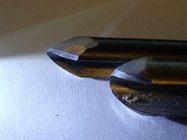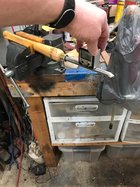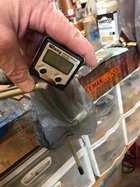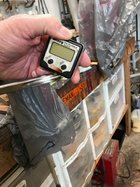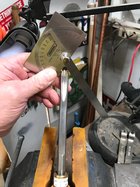Well, this thread sure has diverged.... Love it.
Now, with the Tormek jig, I have a 25+ year old Tormek, which was before the clones came out. To see how that jig worked with the 40/40 grind, I moved the tool bar out till the bevel on one of my platform ground 40/40's matched the wheel curve, I then rolled it to the sides and there was maybe a 1/16 inch gap at the wing, so it needed several more degrees of roll to achieve a true 40/40 grind.
Nose shape is determined by 2 things, one is your flute shape, and the other is the person who is doing the sharpening. I prefer a more rounded nose, and some times it gets a bit pointed with the V flutes from Doug Thompson, and that is totally about me not paying attention to my sharpening. I correct it by spending a bit more time on the nose. Never liked the Glaser V gouge as that one was just too much of a V and the nose was always too pointy. The Jimmy Clewes and Lyle Jamieson gouges that are made by Doug are also V flutes, but more open than Doug's standard V flute.
How important the nose shape is depends a lot on how you turn. If you drop the handle, I would consider the more rounded nose would work better, but haven't turned that way in a long time. Most of the time, I hold my tools more level. I used to turn with the flutes on the side, which I think is what most call 'closed'. I am starting to turn more with the flutes more vertical, like 11, and 1 o'clock. That does make a difference, but still a new method for me. I have heard, I think it was Ashley Harwood, that one way is more aggressive than the other, but I haven't been able to tell. To me, it is more about how hard you are pushing into the wood you are cutting than any particular flute orientation.
Flutes rolled to the side, to me, means that the nose has a high shear angle, and the wing is in more of a scraping mode. Flutes more vertical means that the wing is in almost a peeling cut method and the nose is in more of a scraping mode, but this is generally not used for a roughing cut, more for a finish cut.
With a V flute and the 40/40 grind, the wing is pretty much straight. With the parabolic flute and the 40/40 grind, there is a slight convex shape to the wing. I guess I could say that you can grind a parabolic flute sweep almost straight, if you try, but it wants to turn out slightly arced.
I have one of Doug's U flutes, a 1/2 inch I think. I was not able to get a 40/40 grind on it that seemed to work. Couldn't get a swept back grind on it that I liked either. I did convert it to a 60/40 grind, so 60 degree nose bevel and 40 degrees of sweep. Makes a very good BOB tool for more shallow bowls, and goes very well through the transition.
Rubbing the bevel/floating the bevel. Can't say that I ever noticed that any particular grind of gouge influenced more burnishing as we cut. This is more on the operator. Some unknown skew master said, "the bevel should rub the wood, but the wood should not know it". I have gotten to not like a burnished surface. I have noticed that burnishing is more of a problem on dry wood than on wet wood. Jimmy Clewes mentioned that he didn't like the burnished bowl surface because when you started sanding, first thing you had to do was cut through the burnished surface before you could really sand. I experimented and this seems to be true. Since that time, I use a shear scrape almost exclusively as the final cut on my bowls. This will vary a bit depending on the wood. Probably second preferred method is the NRS, and again, that depends hugely on the wood. Being able to cut with a gouge or skew with no bevel pressure is a skill that takes a lot of practice, and is probably the biggest hurdle for beginners, and pros to overcome. If you get a chance to watch Ashley turn one of her finials for her Christmas ornaments, you will see how much of a dainty touch she has, and that is some thing every turner should aspire to. Learning the 1 handed push cut is to me an essential skill for bowl turning, and the same skill applies to spindles and skews.
You can get skew type shear/angled cuts with a swept back grind, and possibly with the 40/40. You have to drop the tool handle to your hip. This can be done on the outside of a bowl, but not the inside because the lathe gets in the way. This gets your bevel angles much more acute than when presented square on.
I never did figure out how to adapt my robo rest grinding platform to the Tormek. Their platform is on par with the Oneway Wolverine platform, which to me is sadly lacking in repeatability.
robo hippy

